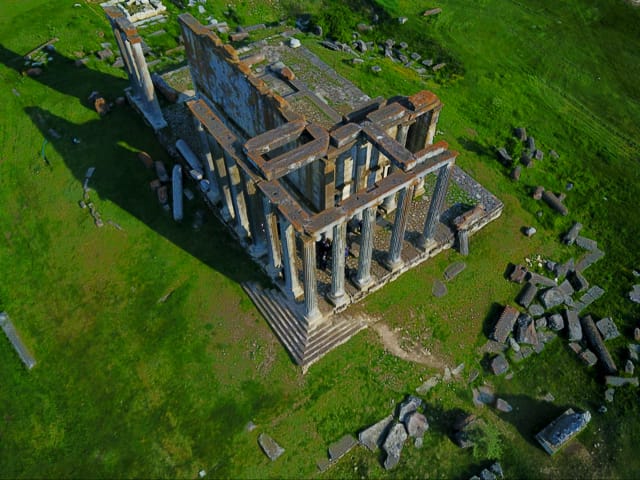Kutahya Castle: A Byzantine and Ottoman Fortress in Turkey
Visitor Information
Google Rating: 4.4
Popularity: Medium
Google Maps: View on Google Maps
Country: Turkey
Civilization: Unclassified
Remains: Military
History
Kutahya Castle stands in the municipality of Maruf, Kütahya, Turkey, and was originally constructed by the Byzantine Empire. Positioned strategically atop a steep hill, the castle served to oversee and control the city below, reflecting its military and administrative importance during Byzantine rule.
Following the Byzantine era, the castle came under Ottoman control, where it continued to function as a fortified military stronghold. The castle was managed by a fortress commander known as the dizdar, who was appointed by imperial decree and held a hereditary land grant called ocaklık. This official also received income derived from local taxes. A complement of 119 tımarlı müstahfiz soldiers formed the garrison, tasked with defending the fortress and sometimes participating in outside military campaigns. The castle’s staff included other roles such as the steward (kethüda), artillery chief, armorer chief, jailer, and gatekeeper, all integral to its operation.
During the late 17th century and extending into the early 19th century, reforms within the Ottoman military affected Kutahya Castle’s forces, linking some soldiers to the Nizam-ı Cedid, a newly established army unit based in Üsküdar, Istanbul. The castle also served a judicial-aspect role as a prison, housing both local offenders and external criminals. Notably, the sons of Gediz Voyvoda Nasuhzâde Nasuh were detained there under the watch of fifty soldiers.
The castle was under regular inspection, at least once a year, by the Anatolian governor. These inspections documented the state of the garrison, prisoners, artillery, and munitions, and held responsible those officials who failed to meet requirements. Throughout the Ottoman period, the castle maintained a functional role in regional defense, justice, and administration.
A significant expansion during the reign of Sultan Mehmed II introduced the “Aşağı Kale,” or Lower Castle, constructed to safeguard the Ilıpınar spring within the castle complex. This addition ensured a reliable water supply during sieges. The Lower Castle included about twenty houses and a small mosque, indicating a settled community in this section of the fortress.
Inside the main fortress, the inner castle or quadrangular citadel featured residences for the dizdar and key officials, a mosque, granaries, and housing, supporting a population that caused occasional social tensions with residents in the lower city. Such disputes, including arguments over access to butchers’ liver supplies, were resolved through imperial edicts, reflecting the castle’s active and complex community life.
Remains
Kutahya Castle occupies a rocky hill characterized by striking blue and reddish stone, taking a roughly pentagonal shape with walls extending about three thousand meters. The fortress sits on sheer cliffs on four sides, with walls rising directly from these precipitous drops, creating a natural and formidable defense without the use of a moat. The defensive walls are punctuated by closely spaced towers, each separated by a distance roughly equal to two arm lengths, forming a continuous ring that encircles the hilltop.
The Lower Castle, or Aşağı Kale, lies at a lower elevation and includes a moat approximately seventy-five meters long. This enclosure was specifically built around the Ilıpınar spring to secure the water source during times of siege. Within this area there remain about twenty houses and a small mosque, connected to the upper fortress by several descending pathways, illustrating its integration into the overall castle complex.
The main entrance faces east and features a prominent three-story iron door. This gate is flanked by ornate white marble lion statues, which overlook the city and provide symbolic as well as defensive functions. Nearby, a guardhouse offers commanding views of the surrounding area, enabling the sentries to monitor city activity effectively.
Within the inner castle, the gate contrasts with the main one through its wooden construction, reinforced with buffalo hide instead of iron. Beyond this entrance lies a relatively open courtyard containing two water cisterns, essential for storing water. Surrounding the courtyard are notable structures including a mosque, the residences of the fortress commander (dizdar), imam, muezzin, and steward, as well as two wheat granaries and eight houses. This arrangement indicates a compact but functional community sustaining the administrative and religious life of the castle.
The castle’s defenses also included two armories and two artillery emplacements. Records from 1817 list seventeen cannons present, including howitzers and mortars. Two of these cannons were positioned on the southeast and northeast sides of the fortress and were specifically fired during Ramadan, marking an Ottoman tradition linked to the holy month.
In addition to these military installations, the castle’s northern-east side features the Kale-i Bâlâ Mosque and a fountain. Both are attributed to the Germiyan period, pointing to layers of architectural and cultural development through different ruling eras.
Together, these archaeological features highlight Kutahya Castle as a complex fortified settlement with military, administrative, and residential components, evolving over centuries to meet the demands of defense, governance, and community life.





